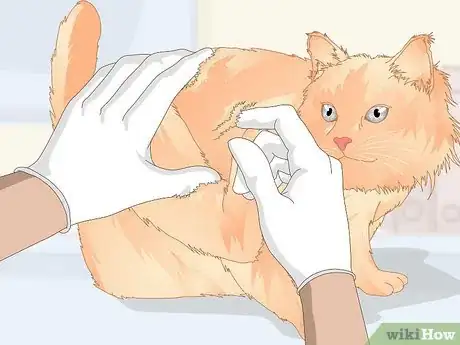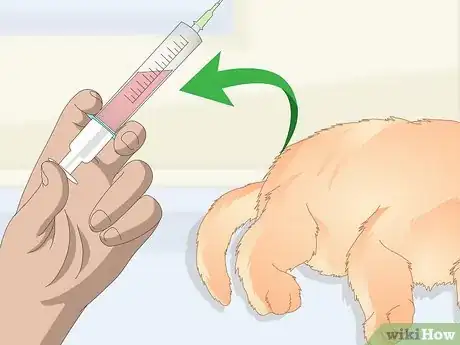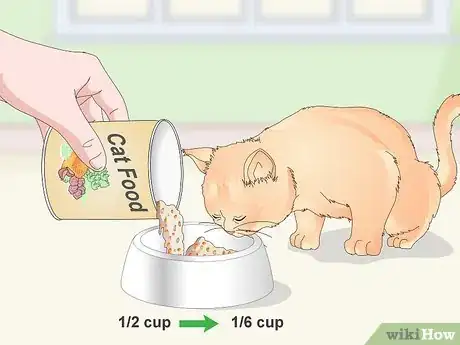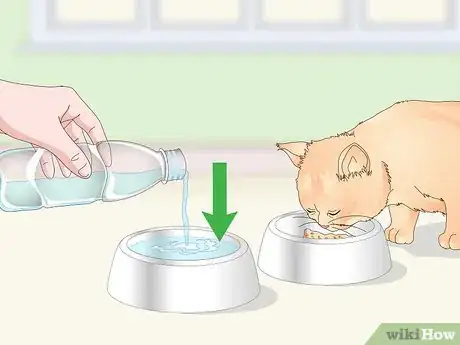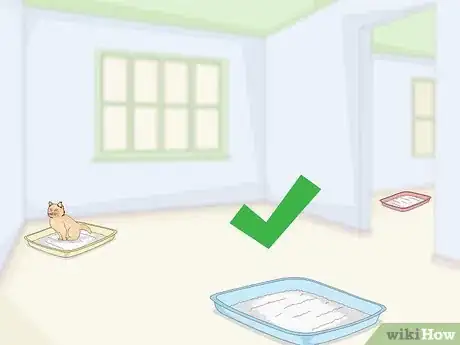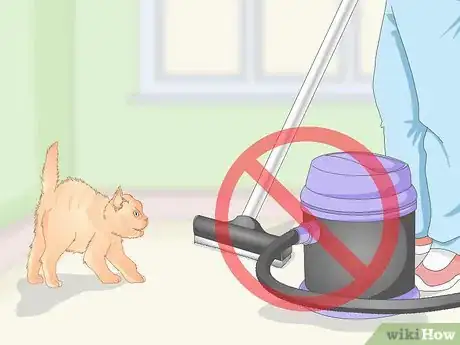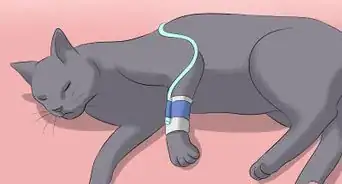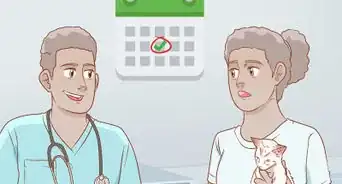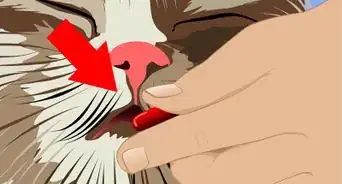This article was co-authored by Melissa Nelson, DVM, PhD. Dr. Nelson is a Veterinarian who specializes in Companion and Large Animal Medicine in Minnesota, where she has over 18 years of experience as a veterinarian in a rural clinic. She received her Doctor of Veterinary Medicine from the University of Minnesota in 1998.
This article has been viewed 41,082 times.
Urinary tract infections are a common health problem for cats, especially older cats. Treating a UTI is usually a matter of taking your cat to see a veterinarian. However, treatment may be a little more involved if your cat’s UTIs are recurring. By getting to the root of the problem with the help of your veterinarian, making some dietary changes, and reducing other risk factors, you may be able to put a stop to your cat’s recurring UTIs and improve its quality of life.
Steps
Seeking Help from a Veterinarian
-
1Take your cat to see a veterinarian at the first sign of an infection. If your cat has had multiple urinary tract infections (UTIs), then the first thing you should do is take it to a veterinarian for evaluation. A veterinarian can find out what is most likely to be causing your cat’s UTIs and make a plan to prevent recurrences. This is especially important if you have a male cat because their bladders can become blocked more easily. Take your cat to see a veterinarian if you notice your cat is:[1]
- Having pain or difficulty urinating
- Passing blood with their urine
- Urinating more frequently than usual
- Urinating in inappropriate places, such as on furniture, in the bathtub, or on the floor
- Trying to urinate but cannot. This is a medical emergency. Take your cat to the vet right away.
-
2Allow your cat’s vet to check for common causes of UTIs. There are several common causes of UTIs that your veterinarian will want to check your cat for. Finding the cause is the best way to prevent a recurrence. Some conditions that may lead to UTIs in cats include:[2]
- Interstitial cystitis
- Viruses and bacteria
- Renal failure
- Diabetes mellitus
- Hyperthyroidism
- Advanced age
Advertisement -
3Expect your cat’s veterinarian to run tests. To find out what type of UTI your cat has and how serious it is, your cat’s veterinarian will need to run some tests on your cat. This information will make it easier for your cat’s vet to treat the UTI and offer advice about how to prevent a recurrence. Some tests your cat’s veterinarian may perform include:[3]
-
4Ask about antibiotics. Depending on the type of UTI your cat has, your veterinarian may prescribe an antibiotic. It is important for a veterinarian to do this based on the results of a urine culture because some infections will only respond to certain antibiotics and not to others. If a bacterial infection is to blame for your cat’s recurring UTIs, then you will need to administer a round of antibiotics as directed by your veterinarian.
- You may need to bring your cat back to the vet in 4 to 6 weeks for a repeat urine culture. If the offending bacteria is no longer present, it will indicate that the antibiotic was effective.[6]
Adjusting Your Cat’s Diet
-
1Evaluate your cat’s diet. Your cat’s diet may be a causing their recurring urinary tract infections if their urine becomes too basic rather than acidic. To ensure that your cat is eating the best possible diet for preventing UTIs, talk with your cat’s veterinarian. They may recommend putting your cat on a special prescription food or at least switching your cat to a different brand of cat food.
- Dry food is more likely to contribute to UTIs than wet food, so you might want to switch your cat to wet food as well.[7]
- If your cat is overweight, your vet may recommend a special diet cat food to help your cat lose weight.
-
2Feed your cat smaller portions more frequently. If your cat tends to eat only once or twice per day, then encouraging it to eat smaller amounts more often may help to prevent recurrences of UTIs, as it may then empty its bladder more frequently. Try encouraging your cat to eat its daily food in 3 or 4 small portions instead of only 1 or 2 portions.[8]
- For example, if you normally put 1/2 of a cup of food in your cat’s bowl in the morning and let it eat as much as it wants, then you might cut that down to 1/6 of a cup. Repeat the same feeding at noon and again in the evening to break down your cat’s daily intake into three feedings.
-
3Provide plenty of clean, fresh water. Keeping your cat well hydrated may also help to prevent recurring UTIs. Refresh your cat’s water bowl in the morning and again at night to ensure that it has plenty to drink. You might also place an extra water dish upstairs or in another part of your house so that it is easier for your cat to access its water.[9]
- Bubblers and cat water fountains may entice your cat to drink more frequently.
Reducing Other Risk Factors
-
1Choose an unscented, non-clumping litter. Litters that are scented and that clump for scooping may also increase your cat’s risk of developing a UTI, as your cat may be put off by them and urinate less frequently. To eliminate this risk factor, replace your cat’s litter with an unscented, non-clumping litter.[10]
- Keep the amount of litter to only 1 inch (2.5 cm) to 2 inches (5.1 cm). Cats that get UTIs prefer smooth surfaces, such as tile and bathtubs, so you may even want to keep a litter box with no litter in it at all to ensure that your cat will use its box.
- Make sure to keep the litter boxes clean by scooping them daily and doing a complete litter box change every week. This will help to reduce the bacteria in the box and encourage your cat to use the box as well. During your weekly litter change, clean your litter box with mild soap and water rather than any harsh chemicals that might repel your cat.
-
2Place multiple litter boxes in your home. Cats that are prone to UTIs may need urinate frequently, and it is important to make sure that they have plenty of options, or they might go on the floor or your furniture. You should have 1 more litter box than the total number of cats in your home.
- For example, if you have 3 cats, then you should have 4 litter boxes in your home.
- Place the litter boxes in quiet corners of your home to ensure that your cat will not be disturbed while it uses the box.[11]
-
3Play with your cat to help it get more exercise. Not getting enough exercise is another contributing factor in whether or not your cat gets UTIs. If your cat is typically sedentary, then try to play with it more often.[12]
- Try using a laser pointer to get your cat to run up and down the hallway or a flight of stairs.
- Use ball toys to give your cat something to chase.
- Get a stick toy with a feather on the end of it to encourage your cat to jump.
-
4Identify potential sources of stress in your cat’s environment. Stress may also contribute to your cat’s UTIs, so it is important to identify and eliminate any potential stressors in your cat’s environment. Consider what tends to frighten or upset your cat and look for ways that you can keep your cat from encountering these things.[13]
- For example, if your cat is afraid of the vacuum cleaner, then put your cat in a separate room before running the vacuum.
- Or, if your cat gets nervous when new people try to pet it, then ask visitors not to approach the cat or pet it unless it comes to them. Cat pheromone collars can also help calm your cat so it’s not so anxious for visitors.
References
- ↑ https://www.petmd.com/cat/conditions/urinary/feline_idiopathic_lower_urinary_tract_disease
- ↑ https://www.petmd.com/cat/conditions/urinary/feline_idiopathic_lower_urinary_tract_disease
- ↑ https://www.petmd.com/cat/conditions/urinary/feline_idiopathic_lower_urinary_tract_disease
- ↑ https://www.petful.com/pet-health/cat-keeps-getting-urinary-tract-infections/
- ↑ https://www.petmd.com/cat/conditions/urinary/feline_idiopathic_lower_urinary_tract_disease
- ↑ https://www.merckvetmanual.com/pharmacology/systemic-pharmacotherapeutics-of-the-urinary-system/bacterial-urinary-tract-infections
- ↑ https://www.avma.org/public/PetCare/Pages/FLUTD.aspx
- ↑ https://www.avma.org/public/PetCare/Pages/FLUTD.aspx
- ↑ https://www.petful.com/pet-health/cat-keeps-getting-urinary-tract-infections/

